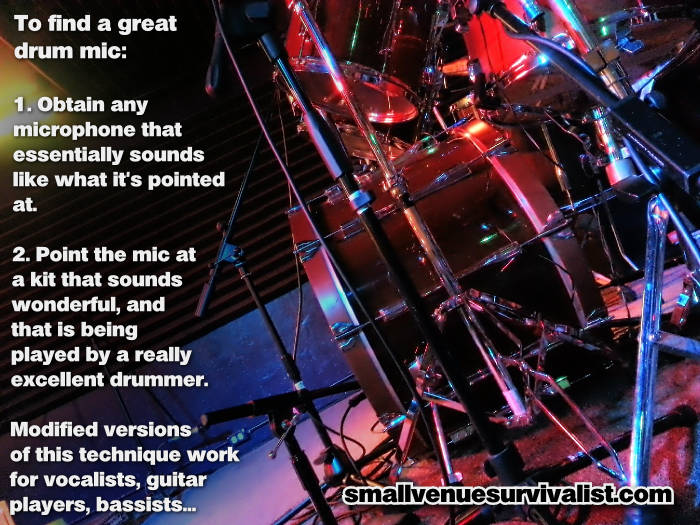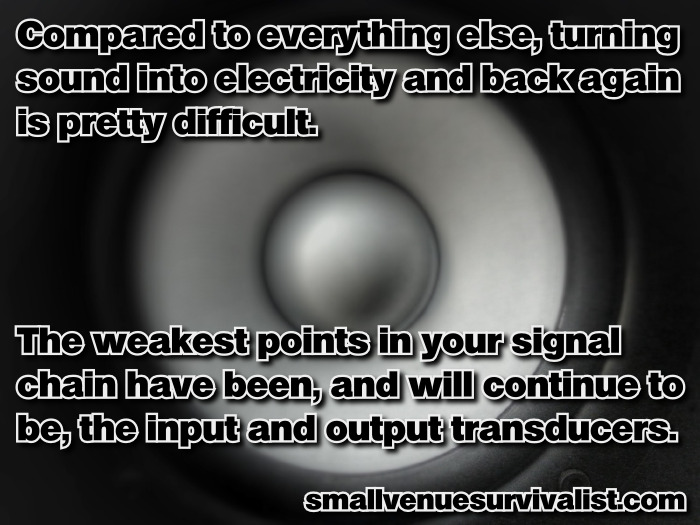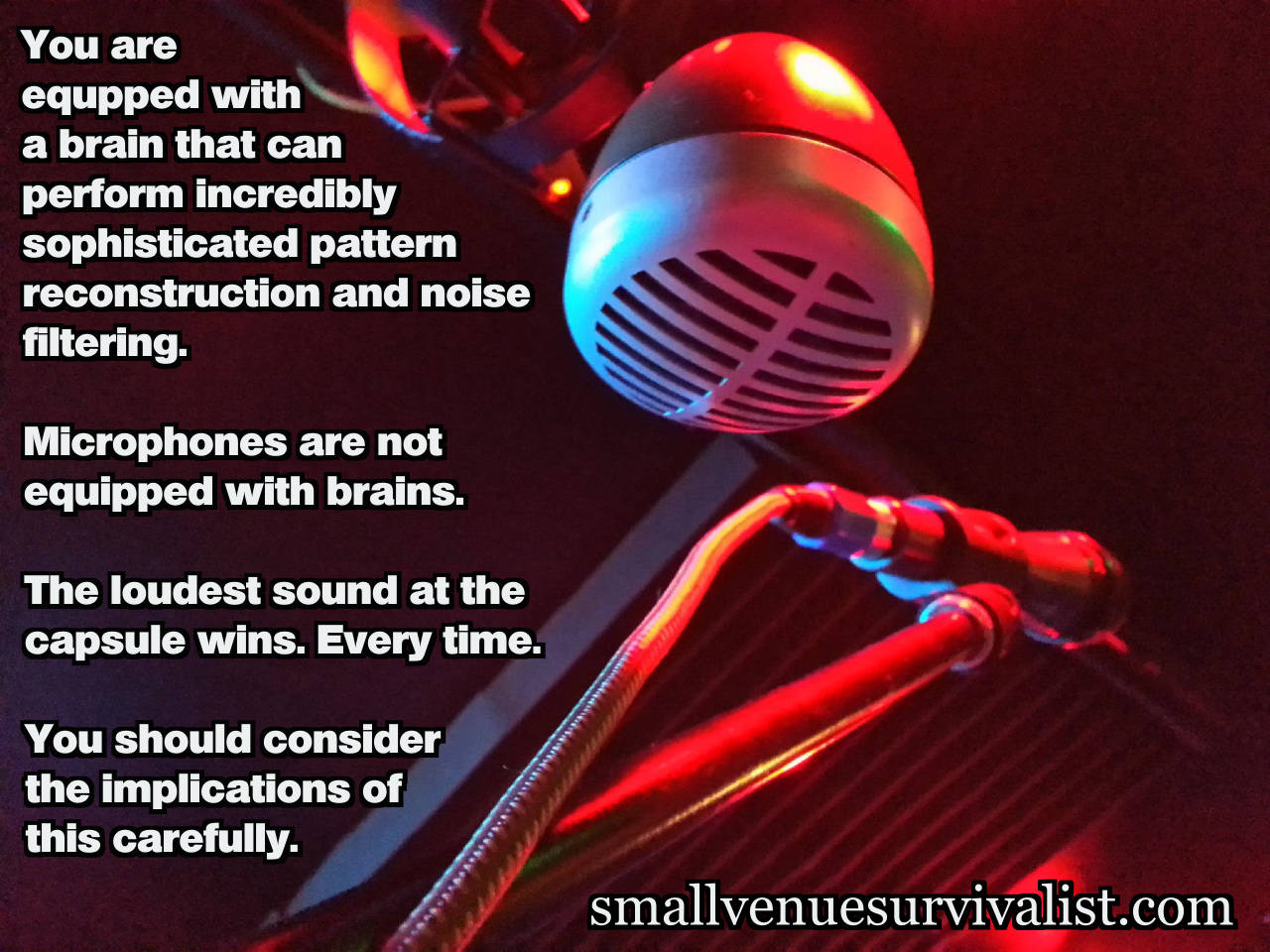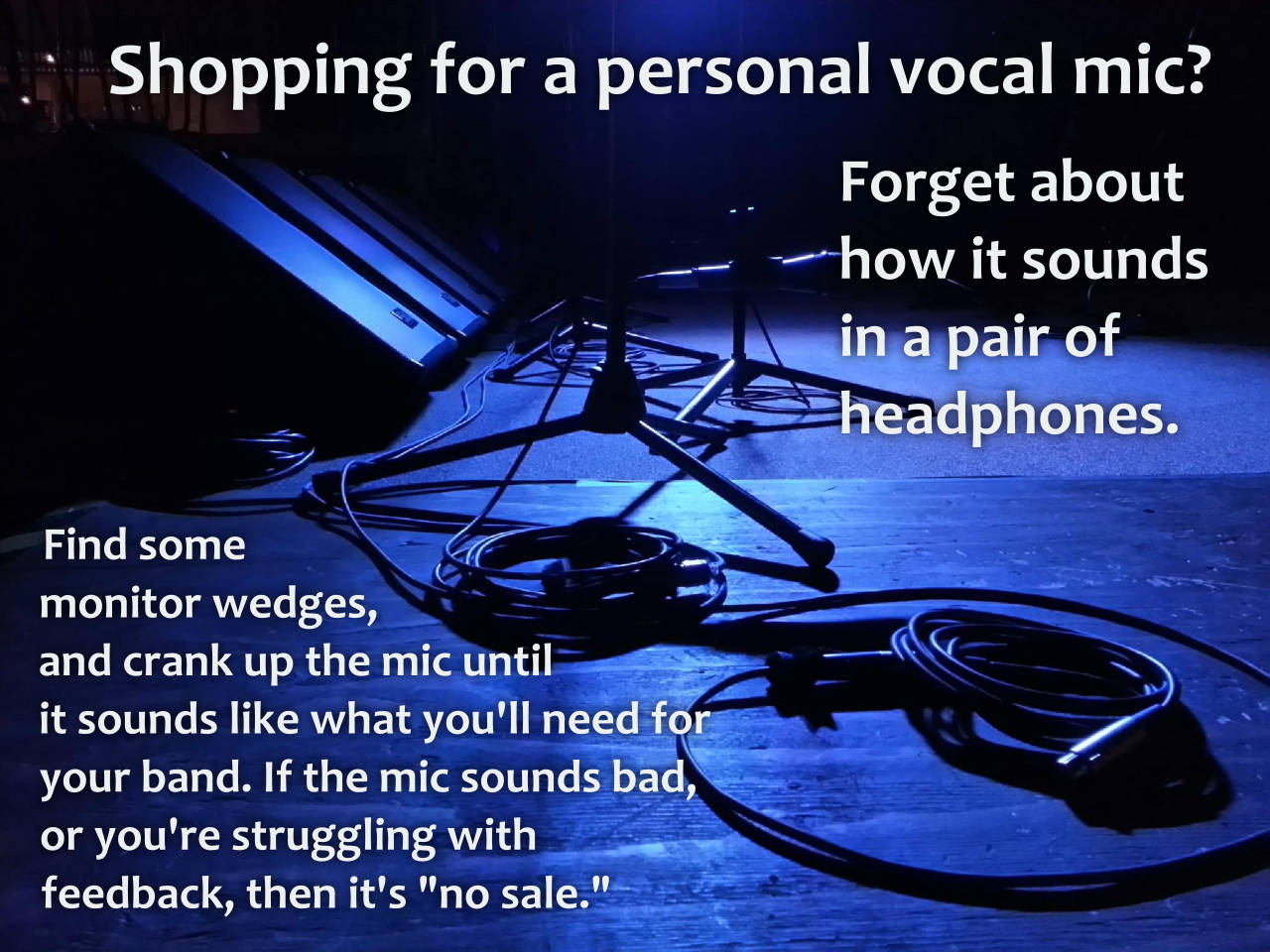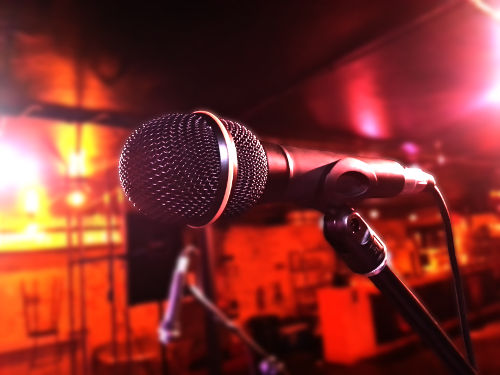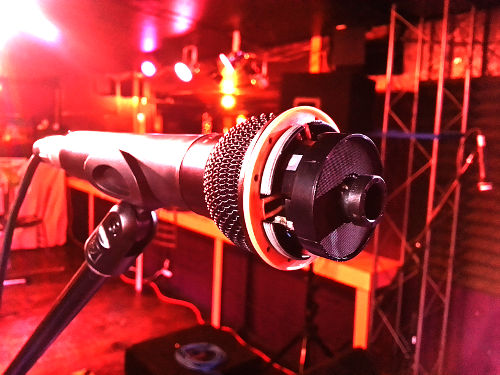Every so often, I’ll work on a set (or even a whole show) where I struggle. It’s why I try to remember to say, “I hope it’s not my night to suck.” I think it’s important to be honest about not being able to work miracles.
Anyway.
Not too long ago, I did a show where the opening act brought an acoustic guitar. Please note my exact words: “Acoustic Guitar.” Not electro-acoustic!
Acoustic guitar. No pickup, that is.
Luckily for me, the opening act’s set was pretty short. This was lucky because I had more feedback problems in that one set than I usually have in two-months-worth of shows. Weird rings. Phantom squeals. High-pitched ghosts that bared their teeth and then disappeared. It was embarrassing, and un-fun.
My mistake primarily lay in trying harder to make the performer happier than the laws of physics would allow. I should have gotten on the talkback and said, “I’m sorry, but I think that’s all we can get out of this setup tonight,” but I didn’t. I tried to fight my way through, and I think the end result was worse for it.
…but everything seemed okay during soundcheck. What went wrong?
The Changing Environment
Your gear isn’t the only thing with a noisefloor. (The noisefloor is the voltage or sound pressure level where non-musical information can be found. It usually sounds like hiss, or rumble, or hum, or a combination of all three.) A venue also has a noisefloor, and unlike a well-maintained piece of equipment, a venue’s noisefloor can change wildly and quickly.
In the case of the problematic set, we were fine at soundcheck. The performer was happy with the onstage blend between his voice and his guitar, and we all liked how things sounded out front.
The venue noisefloor was also about 50 – 60 dB SPLC (Sound Pressure Level, C weighted).
Between soundcheck and the actual show, a rather dramatic thing happened: A whole bunch of college-age humans arrived. Unsurprisingly, most of them were talking to each other. If I had my guess, the new noisefloor was probably between 75 and 85 dB SPLC. In “linear” terms, that’s a magnitude difference with a factor between about 30 and 300.
I’m not joking. An 85 dB SPLC noisefloor is just a bit more than 300 times louder when compared to a 60 dB SPL noisefloor. Logarithmic math is a heck of an eye-opener, I tell ya.
For a performer who’s perception of the “correct” level for their sound was formed in an empty, relatively quiet space, the addition of the crowd certainly had a HUGE effect. What’s more, I’m guessing that the total level on stage was only slightly higher (3 – 6 dB) than the level of the crowd’s conversations. Even worse, the “roar” was probably right in the critical ranges for both the guitar and the vocals.
So, of course, the performer wanted more level from the monitors. He couldn’t hear himself properly anymore – he even said so, outright.
I got on the gas with both the guitar mic and the vocal mic, and that’s when the fight start – I mean, that’s when my feedback issues took hold.
I Had A Problem, So I Added A Mic. Then, I Had Two Problems
Another issue that worked against me was that I had two mics contributing to one “loop.” There was a mic for vocals, and one for the guitar. The mics were in relatively close proximity, and being put through the same monitor.
At high gain.
See where this is going?
Essentially, the two microphones combined into a single, extremely high-gain device that was in a partially closed loop with the wedges. Of course the system was unstable. Of course it was a battle. The gain was so high that, if one of the “so much vocal power that my usual head-amp preset would be driven into hard clip” singers around town had grabbed a mic at that setting, they would have launched a monitor’s LF driver through the grill and into their face.
But here’s the thing:
Gain is proportionally related to acoustic output, but gain is NOT absolutely related to acoustic output.
That is to say, more gain will produce more volume compared to lower gain on the same signal, but the measured, acoustic sound pressure level for any particular gain setting will not always be the same. The entire acoustical and electrical signal chain is ultimately responsible for that.
So, we were running at “super hot” gain levels, but we weren’t all that loud. Unfortunately:
Undamped feedback in a loop is a product of gain, not volume. The only limiting factor that volume represents is that the system must be able to produce enough level to be audible over the noisefloor.
The performer could barely hear himself, but when the system “took off,” all of us could hear THAT just fine.
Reflection and Resonance
There are a couple of other factors that contribute to acoustic guitar feedback issues, especially when monitor wedges are involved.
The first factor is resonance. An acoustic guitar works as an acoustic guitar because of the big, vibrating box that the strings are attached to. The box works because it vibrates in response to external stimuli. The problem is that the box can’t tell the difference between the stimulus presented by the strings, and the stimulus presented by a sufficiently-loud monitor wedge. Get the wedge loud enough at the right frequency, and the resonant acoustic circuit you’ve just unleashed will ring until you do something to stop it.
In the case of the show I’ve been referencing, I don’t think we got the monitors loud enough for wedge-to-body resonance to be a real factor. What may have been a factor, though, is reflection.
Onstage feedback happens when the audio captured by a mic is output through a loudspeaker, and then re-enters the same mic. It doesn’t really matter how the audio returns to the mic – it just matters that it does. So, what do you think happens when a mic is pointed at an acoustic guitar body, which is big, and flat, and not completely absorptive, and which is also right in the path of the audio coming out of the monitors?
Yup.
The monitor audio hits the guitar body and reflects back into the mic. Sure, the lower frequencies might diffract around the guitar, or just pass through the thin walls of the body, but the high frequencies are a different story.
SQUEEEAALLL!
And, of course, the squeal comes and goes, because the guitar player is probably moving around a bit. A lot of the time, you might just barely be okay, and then the guitarist gets everything in just the right alignment…
SQUEEEAALLL!
The Upshot
At this point, the question becomes: “What can we take away from this?”
I think the main takeaway – and it applies to everybody, performers and techs alike – is that a purely acoustic guitar really can’t be expected to be dramatically louder than it already is. Perhaps even more correctly, a purely acoustic guitar can’t be expected to be dramatically louder than it is, as experienced by the microphone capsule.
As a result, if an acoustic guitar needs to be at 90 dB SPL in order to compete with a rowdy crowd, then it really needs to be making at least 87 dB SPL without any help from the PA. If, for some reason, the guitar needs to be a great deal (10 dB or more) louder than it is naturally, then we must have some way of “partially opening the loop” that includes the guitar, the mic, and the audio rig. Either that, or we have to make the guitar much louder – from the mic’s perspective – than the wedges and main PA.
The most practical way to do this is with an internal pickup, optionally coupled with a soundhole cover. The internal pickup gains some isolation by virtue of being inside the guitar body (or outside, but directly coupled to some part of the guitar), and the mic also “perceives” the guitar as being quite loud.
Because it’s, you know, inside or directly attached to the guitar. Life is pretty loud right there, just like it’s really loud inside a piano.
The soundhole cover helps by providing even more isolation from external sounds, and also by changing the resonant frequency of the guitar body. The size and shape of the soundhole is a major component in determining what an acoustic guitar sounds like, and closing the hole may just shift the body resonance to a non-problematic area.
In the end, we all need to know our abilities, and the abilities of our tools, and be aware of when we’re asking too much of ourselves or our gear. We also need to be able to look back at our problems with an analytical eye, and figure out exactly what went wrong.
Of course, I’ll probably end up trying to break the laws of physics again in six months, because I have a short memory for situations I don’t encounter every week…

